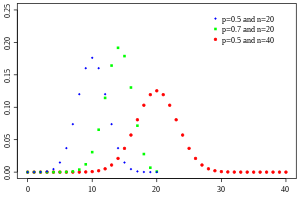Binomial distribution
|
Probability mass function

|
|
|
Cumulative distribution function

|
|
| Notation | B(n, p) |
|---|---|
| Parameters |
n ∈ N0 — number of trials p ∈ [0,1] — success probability in each trial |
| k ∈ { 0, …, n } — number of successes | |
| pmf | |
| CDF | |
| Mean | |
| Median | or |
| or | |
| Variance | |
| Skewness | |
| Ex. kurtosis | |
| Entropy |
in . For , use the natural log in the log. |
| MGF | |
| PGF | |
| Fisher information |
(for fixed ) |
In probability theory and statistics, the binomial distribution with parameters n and p is the discrete probability distribution of the number of successes in a sequence of n independent yes/no experiments, each of which yields success with probability p. A success/failure experiment is also called a Bernoulli experiment or Bernoulli trial; when n = 1, the binomial distribution is a Bernoulli distribution. The binomial distribution is the basis for the popular binomial test of statistical significance.
The binomial distribution is frequently used to model the number of successes in a sample of size n drawn from a population of size N. If the sampling is carried out without replacement, the draws are not independent and so the resulting distribution is a hypergeometric distribution, not a binomial one. However, for N much larger than n, the binomial distribution remains a good approximation, and widely used.
In general, if the random variable X follows the binomial distribution with parameters n ∈ ℕ and p ∈ [0,1], we write X ~ B(n, p). The probability of getting exactly k successes in n trials is given by the probability mass function:
...
Wikipedia














![G(z)=\left[(1-p)+pz\right]^{n}.](https://wikimedia.org/api/rest_v1/media/math/render/svg/b882d226739a271dd2d513336fb42612be9f714f)

